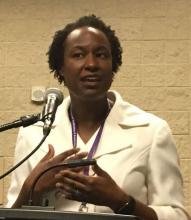ORLANDO – Less than half of children could identify a real gun from a toy gun in photos, regardless of whether their parents owned a gun or had talked to them about firearm safety, according to a new study.
“That is very concerning to us because a large percentage of these parents are actually storing their firearms insecurely and then their children cannot tell the difference,” study investigator Kiesha Fraser Doh, MD, reported at the annual conference of the American Academy of Pediatrics.
Dr. Fraser Doh, assistant professor of pediatrics and emergency medicine physician at Emory University School of Medicine and Children’s Healthcare of Atlanta said she was inspired to conduct this study after she noticed she was seeing approximately one firearm injury in children about every 2½ weeks in her institution. She also realized that her own child frequently went on play dates, but she did not always think to ask about firearms in the home of the friends her child visited.
An estimated one in three U.S. children live in homes with a firearm, she explained, and many of these guns are left loaded and/or unlocked.
The researchers enrolled a convenience sample of 297 English-speaking caregivers who presented at one of three pediatrics EDs over 3 months. Two were suburban departments, and one was urban.
Overall, most respondents (79%) were female and 56% were black, while 33% were white. Most of the caregivers responding had some college education (72%), and just over half (51%) had an income greater than $50,000.
The researchers asked caregivers whether they had guns in their own home and whether their child had access to firearms in their own or other homes. They also asked if their child played with toy guns and whether they believed their child could tell the difference between a real gun and a toy one.
Compared with those who did not own guns, gun owners were significantly more likely to be white and have both an income over $50,000 and some college education.
Meanwhile, researchers showed the children, aged 7-17 years, photos of a toy gun and a real gun and asked which was which.
A quarter of the caregivers (25%) owned guns, and half of them (50%) allowed their children to play with guns, compared with 26% of the non-gun owners.
In addition, 86% of the gun owners had discussed gun safety with their children, and the same proportion believed their children could correctly distinguish between a real gun and a toy gun.
By comparison, 58% of the non-gun owners had discussed gun safety with their children, and the same percentage believed their children could tell the difference between real and fake guns.
The children’s confidence in being able to tell the difference was similar regardless of whether their parents owned guns (79%) or didn’t (76%).
Yet less than half of all children correctly identified the real gun in the photos: 39% of the gun owners’ children and 42% of the non-gun owners’ children correctly pointed out the real gun, a nonsignificant difference.
Throughout the entire sample, more than 8 in 10 respondents, both gun owners (86%) and not (84%), believed there should be a law that requires caregivers to store their guns safely. A similar proportion (85% of gun owners and 80% of non-gun owners) believed legal penalties should exist for caregivers “if a child encounters an unsecured firearm.”
Overall, 5% of the respondents (14% of gun owners and 4% of non-gun owners) believed their child could get a gun within 24 hours if desired.
“So what does this mean to us as clinicians? It behooves [pediatricians] to actually continue to educate families at well-child visits on the guidelines about how to store firearms safely, locked up, unloaded, separate from ammunition,” Dr. Fraser Doh said. “On the flip side, parents need to be asking about the presence of firearms in the homes their children visit and also make sure that they’re storing their weapons safety.”
Dr. Fraser Doh said she had no relevant conflicts of interest.


